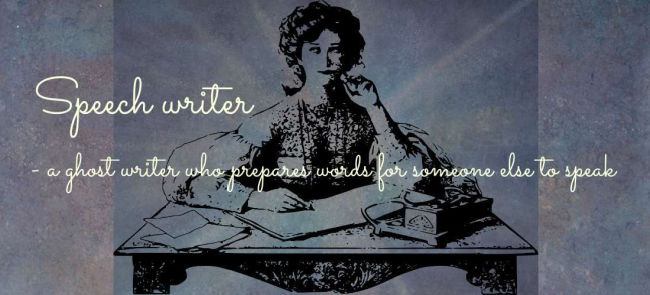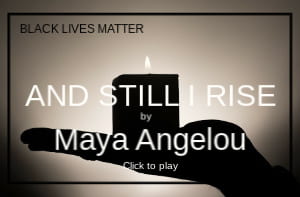- HOME ›
- Types of speeches
The 4 types of speeches
Informative, demonstrative, persuasive and special occasion
By: Susan Dugdale | Last modified: 01-31-2024
There are four main types of speeches or types of public speaking.
- Informative
- Demonstrative
- Persuasive
- Special occasion or Entertaining
To harness their power a speaker needs to be proficient in all of them: to understand which speech type to use when, and how to use it for maximum effectiveness.
What's on this page:
An overview of each speech type, how it's used, writing guidelines and speech examples:
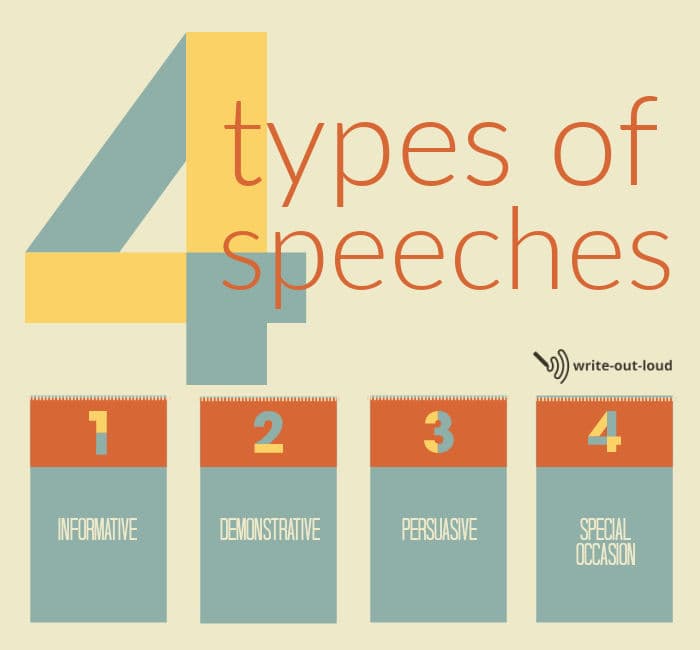
Informative speeches
An informative speech does as its name suggests: informs. It provides information about a topic. The topic could be a place, a person, an animal, a plant, an object, an event, or a process.
The informative speech is primarily explanatory and educational.
Its purpose is not to persuade or influence opinion one way or the other. It is to provide sufficient relevant material, (with references to verifiable facts, accounts, studies and/or statistics), for the audience to have learned something.
What they think, feel, or do about the information after they've learned it, is up to them.
This type of speech is frequently used for giving reports, lectures and, sometimes for training purposes.
Examples of informative speech topics:
- the number, price and type of dwellings that have sold in a particular suburb over the last 3 months
- the history of the tooth brush
- how trees improves air quality in urban areas
- a brief biography of Bob Dylan
- the main characteristics of Maine Coon cats
- the 1945 US bombing of Hiroshima and Nagasaki
- the number of, and the work of local philanthropic institutions
- the weather over the summer months
- the history of companion planting
- how to set up a new password
- how to work a washing machine
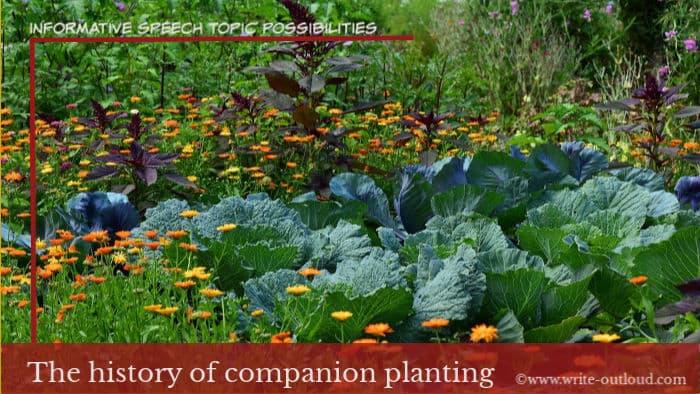
Click this link if you'd like more informative topic suggestions. You'll find hundreds of them.
And this link to find out more about the 4 types of informative speeches: definition, description, demonstration and explanation. (Each with an example outline and topic suggestions.)

Demonstration, demonstrative or 'how to' speeches
A demonstration speech is an extension of an informative process speech. It's a 'how to' speech, combining informing with demonstrating.
The topic process, (what the speech is about), could either be demonstrated live or shown using visual aids.
The goal of a demonstrative speech is to teach a complete process step by step.
It's found everywhere, all over the world: in corporate and vocational training rooms, school classrooms, university lecture theatres, homes, cafes... anywhere where people are either refreshing or updating their skills. Or learning new ones.
Knowing to how give a good demonstration or 'how to' speech is a very valuable skill to have, one appreciated by everybody.
Examples of 'how to' speech topics are:
- how to braid long hair
- how to change a car tire
- how to fold table napkins
- how to use the Heimlich maneuver
- how to apply for a Federal grant
- how to fill out a voting form
- how to deal with customer complaints
- how to close a sale
- how to give medicine to your cat without being scratched to bits!

Resources for demonstration speeches
1.How to write a demonstration speech
Guidelines and suggestions covering:
- choosing the best topic: one aligning with your own interests, the audience's, the setting for the speech and the time available to you
- how to plan, prepare and deliver your speech - step by step guidelines for sequencing and organizing your material plus a printable blank demonstration speech outline for you to download and complete
- suggestions to help with delivery and rehearsal. Demonstration speeches can so easily lurch sideways into embarrassment.
For example: forgetting a step while demonstrating a cake recipe which means it won't turn out as you want it to.
Or not checking you've got everything you need to deliver your speech at the venue and finding out too late, the very public and hard way, that the lead on your laptop will not reach the only available wall socket. Result. You cannot show your images.

2. Demonstration speech sample outline
This is a fully completed outline of a demonstration speech. The topic is 'how to leave an effective voice mail message' and the sample covers the entire step by step sequence needed to do that.
There's a blank printable version of the outline template to download if you wish and a YouTube link to a recording of the speech.
3. Demonstration speech topics
4 pages of 'how to' speech topic suggestions, all of them suitable for middle school and up.

Persuasive speeches
The goal of a persuasive speech is to convince an audience to accept, or at the very least listen to and consider, the speaker's point of view.
To be successful the speaker must skillfully blend information about the topic, their opinion, reasons to support it and their desired course of action, with an understanding of how best to reach their audience.
Everyday examples of persuasive speeches
Common usages of persuasive speeches are:
- what we say when being interviewed for a job
- presenting a sales pitch to a customer
- political speeches - politicians lobbying for votes,
- values or issue driven speeches e.g., a call to boycott a product on particular grounds, a call to support varying human rights issues: the right to have an abortion, the right to vote, the right to breathe clean air, the right to have access to affordable housing and, so on.
Models of the persuasive process
The most frequently cited model we have for effective persuasion is thousands of years old. Aristotle, the Greek philosopher, 384–322 BC, explained it as being supported by three pillars: ethos, pathos and logos.
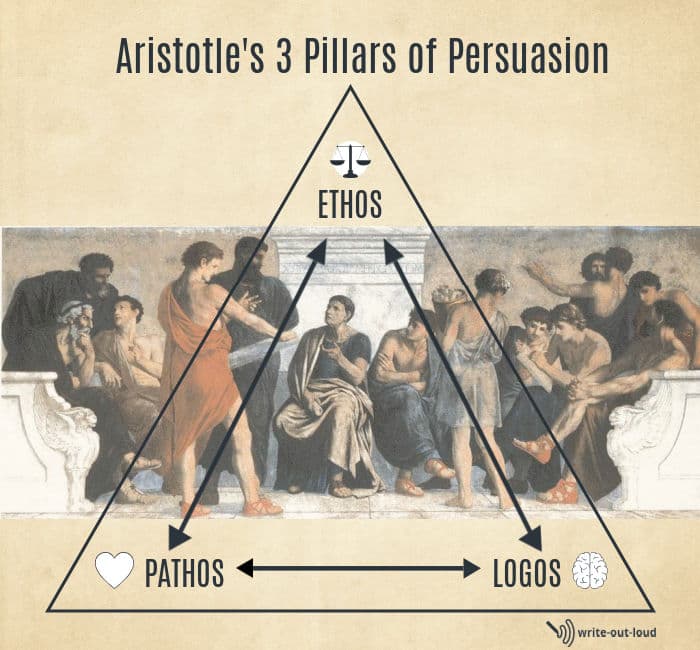
Ethos
Briefly, ethos is the reliability and credibility of the speaker. How qualified or experienced are they talk on the topic? Are they trustworthy? Should we believe them? Why?
Pathos
Pathos is the passion, emotion or feeling you, the speaker, bring to the topic. It's the choice of language you use to trigger an emotional connection linking yourself, your topic and the audience together, in a way that supports your speech purpose.
(We see the echo of Pathos in words like empathy: the ability to understand and share the feels of another, or pathetic: to arouse feelings of pity through being vulnerable and sad.)
Logos
Logos is related to logic. Is the information we are being presented logical and rational? Is it verifiable? How is it supported? By studies, by articles, by endorsement from suitably qualified and recognized people?
To successfully persuade all three are needed. For more please see this excellent article: Ethos, Pathos, Logos: 3 Pillars of Public Speaking and Persuasion
Monroe's Motivated Sequence of persuasion
Another much more recent model is Monroe's Motivated Sequence based on the psychology of persuasion.

It consists of five consecutive steps: attention, need, satisfaction, visualization and action and was developed in the 1930s by American Alan H Monroe, a lecturer in communications at Purdue University. The pattern is used extensively in advertising, social welfare and health campaigns.
Resources for persuasive speeches
1. How to write a persuasive speech
Step by step guidelines covering:
- speech topic selection
- setting speech goals
- audience analysis
- empathy and evidence
- balance and obstacles
- 4 structural patterns to choose from
2. A persuasive speech sample outline using Monroe's Motivated Sequence
3. An example persuasive speech written using Monroe's Motivated Sequence
4. Persuasive speech topics: 1032+ topic suggestions which includes 105 fun persuasive ideas, like the one below.☺

Special occasion or entertaining speeches
The range of these speeches is vast: from a call 'to say a few words' to delivering a lengthy formal address.
This is the territory where speeches to mark farewells, thanksgiving, awards, birthdays, Christmas, weddings, engagements and anniversaries dwell, along with welcome, introduction and thank you speeches, tributes, eulogies and commencement addresses.
In short, any speech, either impromptu or painstakingly crafted, given to acknowledge a person, an achievement, or an event belongs here.
You'll find preparation guidelines, as well as examples of many special occasion speeches on my site.
Resources for special occasion speeches
How to prepare:
- an acceptance speech, with an example acceptance speech
- a birthday speech, with ongoing links to example 18th, 40th and 50th birthday speeches
- an office party Christmas speech, a template with an example speech
- an engagement party toast, with 5 examples
- a eulogy or funeral speech, with a printable eulogy planner and access to 70+ eulogy examples
- a farewell speech, with an example (a farewell speech to colleagues)
- a golden (50th) wedding anniversary speech, with an example speech from a husband to his wife
- an impromptu speech, techniques and templates for impromptu speaking, examples of one minute impromptu speeches with a printable outline planner, plus impromptu speech topics for practice
- an introduction speech for a guest speaker, with an example
- an introduction speech for yourself, with an example
- a maid of honor speech for your sister, a template, with an example
- a retirement speech, with an example from a teacher leaving to her students and colleagues
- a student council speech, a template, with an example student council president, secretary and treasurer speech
- a Thanksgiving speech, a template, with an example toast
- a thank you speech, a template, with an example speech expressing thanks for an award, also a business thank you speech template
- a tribute (commemorative) speech, with a template and an example speech
- a welcome speech for an event, a template, an example welcome speech for a conference, plus a printable welcome speech planner
- a welcome speech for new comers to a church, a template with an example speech
- a welcome speech for a new member to the family, a template with an example
Speech types often overlap
Because speakers and their speeches are unique, (different content, purposes, and audiences...), the four types often overlap. While a speech is generally based on one principal type it might also have a few of the features belonging to any of the others.
For example, a speech may be mainly informative but to add interest, the speaker has used elements like a demonstration of some sort, persuasive language and the brand of familiar humor common in a special occasion speech where everybody knows each other well.
The result is an informative 'plus' type of speech. A hybrid! It's a speech that could easily be given by a long serving in-house company trainer to introduce and explain a new work process to employees.
Related pages:
- how to write a good speech. This is a thorough step by step walk through, with examples, of the general speech writing process. It's a great place to start if you're new to writing speeches. You'll get an excellent foundation to build on.
- how to plan a speech - an overview of ALL the things that need to be considered before preparing an outline, with examples
- how to outline a speech - an overview, with examples, showing how to structure a speech, with a free printable blank speech outline template to download
- how to make and use cue cards - note cards for extemporaneous speeches
- how to use props (visual aids)
And for those who would like their speeches written for them:
